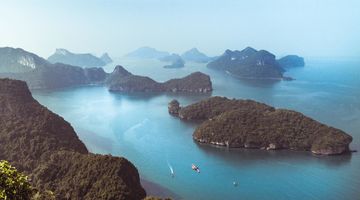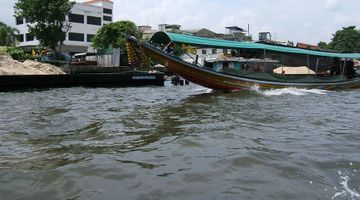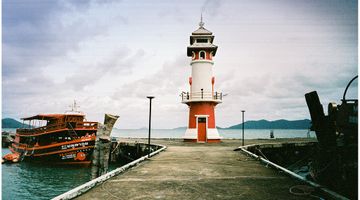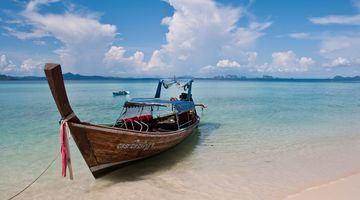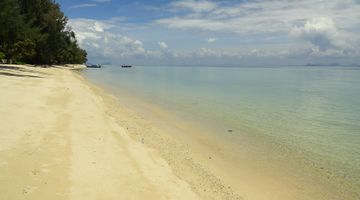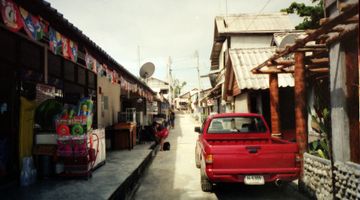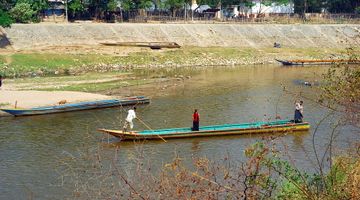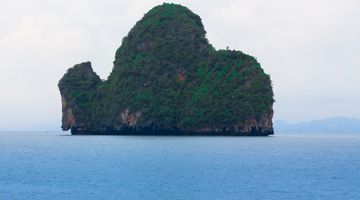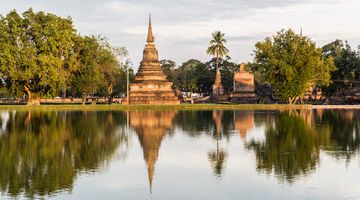5 Best Diving Destinations in Thailand & Top Tips to Enjoy It
The dive sites in Thailand are amongst the most visited sites in the entire world. Having the luxury of both of the Andaman Sea and Gulf of Thailand on either side of its shores, the country is not short of warm, tropical water and all the incredible creatures that inhabit it.
Best seasons for diving
If the good news is that Thailand is full of incredible dive sites and surreal beaches, then the great news is that these places are always within your reach. While there are certainly times in the year that allow for the greatest possible experience, you just can’t go wrong by spontaneously booking your ticket, and making your way to the land of smiles.
As a general rule, the months between November and April are the best for diving. The superior water clarity and abundance of wildlife make for picture perfect, memorable underwater scenes. If you’re coming to the sandy shores of Thailand to promptly hop upon a liveaboard to the Similan islands, this is when you are going to want to do it.
The absolute best time to visit each area of Thailand and its dive sites vary. If you’re looking to visit one of the many sites on the west coast, try and miss the months between May and October. Rainy conditions affect water clarity. If you’re constrained to a trip within these months, you’d be better off spending it one of the sites within the Gulf of Thailand where the sun is shining and the good times are rolling.
What to expect
As if there is no end to the good news in the realm of underwater adventures in Thailand, you’ll be glad to know that the prices of certifications, lessons, and dives are amongst the cheapest in the world. For all the backpackers on a shoe-string budget, this is nothing short of a symphony. Those who have yet to submerge themselves into the world of scuba diving would do well to remember the name “Koh Tao”. It is a tiny island just off Koh Phangan in the Gulf of Thailand. Its importance lies in the fact that the tiny little speck of land has over fifty dive shops, all fiercely competing and vying for your business. As a result, this wondrous little place is the cheapest place on earth to get certified. From there, you’ll be free to plunge yourself into the surrounding reefs and in amongst the astounding marine life.
A typical course will take you around three days to complete. There will be texts you need to read, videos you need to watch, and a couple of tests you need to take. None of these are nearly as scary as they sound, and are simple enough for anyone older than twelve. Of course, you’ll do your first few dives, too! The whole course will set you back around THB 10,000. This will cover absolutely everything you need, including your accommodation for the three days.
Thankfully, you don’t actually need to be certified to join in on the festivities down below. It is possible to have one time dive experiences that will only have you training half a day before you’re swimming with the fishes. This is ideal for those on a family holiday, or those who have limited time in Thailand.
For forever changed people who’ve dived before, fun dives around Thailand will cost anything between 700 and 1500 THB. The amount of dives you book with the company, and how much of your own equipment you use will influence what you end up paying.
Underwater world in Thailand
Devastation of coral reefs in the Andaman sea side of Thailand was it its worst in the 1970’s and 80’s. Dynamite bombing decimated the marine life and left little more than the rubble of once astounding marine life. Fishing and tourism has done its fair share of devastation to the marine life near Phuket and the dive sites surrounding Coral island. Irresponsible and unsustainable behaviours have left the once majestic reefs bland and hardly worth a snorkel. However, not all is lost. Not only have there been significant recovery efforts in these areas, showing a fantastic 24 percent improvement in the health of the corals, but there are many other sites in less touristy areas that have been well protected to date, and as such, have thriving micro ecosystems.
While half the thrill of stepping into the habitat of wild animals is not knowing what you will see and when you will see it, Thailand’s popular dive sites are frequently visited by some big and impressive fish. Among the names that make people gasp and make unplanned leaps into the water are whale sharks, turtles, many kinds of rays, black-tip reef sharks, white-tip reef sharks, etc.
There is, of course, so much else to see. Richelieu rock is home to many shrimp, several varieties of clownfish, seahorses, incredibly diverse and vibrant corals, moray eels, and schools of colourful fish. This is, it itself, enough reason to visit the brilliant dive site.
Other dive sites are renowned for their unusual rock formations below the surface. Massive boulders, pinnacles, coral walls and dramatic swim-throughs all fill you with a distinct sense of childlike giddiness.
Top-5 diving destinations in Thailand
1. Similan islands
A trip to the Similan islands is a pre-requisite for anyone who fancies themselves a diver. The set of islands is so renowned that it is essentially synonymous with the phrase ‘I went diving in Thailand’. The national park consists of nine incredible little islands that are best visited during the months between November and March. If you’re serious about seeing them properly, then be sure to grab a ticket on one of the many liveaboards. The trips run for anything from two to seven days, and will provide you with an unencumbered, sensationally rich experience of the islands.
Liveaboards range extensively in cost, accordingly, they range extensively in comfort. If you’re willing to skimp on some of the comforts of your regular day-to-day, then you can be roaming the Andaman for as little as 15 000 THB. Spend over double that and you’ll be dining and sleeping in something akin to the titanic – well, maybe not quite the suite that Rose enjoyed. Do your research into these trips, there are just so many to choose from and will certainly be one to suit your needs.
In amidst the hordes of tiny creatures that are in abundance in these waters, there are also a handful of larger animals you may come across. Several sharks, marble, eagle and manta rays, barracuda, and even whale sharks are known to visit the dive sites.
To keep your eyes wide-open in amazement, your sightings of sea-life will be punctuated by impressive rock formations and so many brilliant and vibrant corals.
2. Hin Daeng / Hin Muang
Best experienced via a liveaboard exploring the sites around Koh Phi Phi and Koh Ha, this is a site that you don’t want to miss. It is difficult to explain the sense of wonder and peace that you feel when into your field of vision floats a manta ray. Really, this feeling must be experienced with your whole body, your whole existence.
These dive sites are renowned for more than just the frequent sightings of manta rays and whale sharks though. Hin Daeng translates to Red Rock, a site in which a massive red boulder is surrounded by corals in more shades of red that you thought possible. Fish, so many fish, swarm its surrounds. Just the sheer number of the fish is astounding.
Cheap liveaboards that visit these sights and the Phi Phi islands last for three days and usually include 10 dives. The currents can be strong in these parts, so you need to be sure that you are a competent and comfortable diver before you take them on.
3. Richelieu rock
Just below the Myanmar border, and not far away from the most northern of the Similan islands, is a special place filled with magical creatures, incredible limestone casts, and a constant supply of supremely grateful humans. Richelieu rock is the name, and should you have done any research about dive sites in Thailand, you’re sure to have heard about it.
Nutrient rich water attracts an uncountable number of fish and more whale sharks than anywhere else in the country. Not only do you have a great chance of seeing one of these gentle giants, you are guaranteed to be surrounded by immense, brightly lit schools of fish, cosy, colourful caves, slow-moving corals, and just so many opportunities for a stunning macro-photography shot.
4. Koh Tao
Koh Tao has developed into the diving mecca that is for a very good, and really, quite obvious reason – the diving is sensational!
There are many dive sites off and around the island. Chumphon Pinnacle is maybe the best site of them all. Several pinnacles that are covered in soft corals are often surrounded by shoals of brightly lit fish. This is a popular spot though, so you’re unlikely to experience it in tranquillity.
Sail rock is also a pretty incredible site. While it is a full two hours away from Koh Tao, if you’re willing to make the trip, you’ll be rewarded with an amazing swim through, large pelagic fish, and impressive rock structures.
Take the time to research what dives you would love to do before you arrive. Talk with several schools and establish who can give you what you need for a price you’re willing to pay.
5. Pattaya
While the underwater world in Pattaya is not that stunning and cannot compete even with Koh Tao – not to speak about the Andaman Sea – Pattaya is a fantastic place to do some wreck diving! As much as five world-famous ship wrecks are at your fingertips here. These dives are only open to divers with some experience, and some only open to Advanced Divers. Should you be legible, and hopefully free from the curse of claustrophobia, you can swim through the engine room and the ships passageways. All the wrecks are truly quite magnificent, and will take you several days to see them all!
Top tips to get most of your Thai diving experience
- Dive insurance is a necessary part of your entire experience. Without it, really letting go and being the moment will be much harder, and could even be called irresponsible. Being a world-renowned name is travel insurance, World Nomads is a good option. They are reputable, and often include diving insurance under their usual insurance policies. This will help you save a chunk of change, and will also give you the peace of mind that you’re after.
- Bring an underwater camera! If you don’t have one, you won’t have any trouble getting one through the school that you book your dives with. With the incredible world that awaits you down below, you going to want to have something to show the family back home.
- If you’re going on a liveaboard and have specific dietary requirements, be sure to discuss this with the company in advance. Remember, the food served on these trips is usually standard Thai cuisine. If you’re not especially into spicy and flavourful food, bring something along for yourself.
- Bring all your personal diving gear except tanks, weights and your weight belt. These basics will always be provided for you.
- Confirm whether the liveaboard that you’re going on provides dive insurance as a part of the package they offer. It may be wise to have your own dive insurance anyway.
- Take the time between your dives to check out the beaches. One of the great perks of te liveaboards is the level of seclusion you’ll have on these beaches!
- Wear a wetsuit. Considering the high temperatures all year round, it is dangerous to not in these parts.
- Always wear sunscreen, your mother was right.
- If you plan on doing a night dive, make sure that you will have a torch with you. This will give you access to those dark corners and crevices where tiny but wonderful creatures live.
- Confirm whether accommodation is included on your overnight trips.
- Be safe first. Be inspired second.








